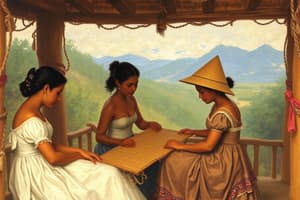Podcast
Questions and Answers
How does textile art primarily contribute to cultural preservation in the modern era?
How does textile art primarily contribute to cultural preservation in the modern era?
- By standardizing designs to appeal to global markets.
- By focusing solely on innovative, non-traditional designs.
- By serving as a medium for passing down traditional stories, techniques, and cultural values. (correct)
- By creating mass-produced souvenirs for tourists.
In what way does textile art uniquely foster social cohesion within communities today?
In what way does textile art uniquely foster social cohesion within communities today?
- By providing shared creative activities that reinforce community bonds and collective identity. (correct)
- By limiting participation to only master weavers.
- By focusing solely on the economic benefits of textile sales.
- By promoting individual artistic expression over collaborative creation.
How does the appreciation of textile art contribute to a broader understanding of cultural diversity in a globalized world?
How does the appreciation of textile art contribute to a broader understanding of cultural diversity in a globalized world?
- By promoting the idea that all textiles are essentially the same, regardless of origin.
- By emphasizing the superiority of certain textile traditions over others.
- By standardizing textile production to create a uniform global aesthetic.
- By highlighting the unique techniques, materials, and stories embedded within diverse textile traditions. (correct)
What role does textile art play in promoting sustainable practices within the fashion and design industries?
What role does textile art play in promoting sustainable practices within the fashion and design industries?
How does textile art contribute to economic empowerment within marginalized communities?
How does textile art contribute to economic empowerment within marginalized communities?
What is the primary distinguishing characteristic of Pis Syabit?
What is the primary distinguishing characteristic of Pis Syabit?
How does Seputangan differ functionally from Pis Syabit?
How does Seputangan differ functionally from Pis Syabit?
What weaving technique is most closely associated with the creation of Inaul?
What weaving technique is most closely associated with the creation of Inaul?
Which cultural group is primarily associated with the creation and use of Pis Syabit?
Which cultural group is primarily associated with the creation and use of Pis Syabit?
What distinguishes Inaul from both Pis Syabit and Seputangan in terms of material?
What distinguishes Inaul from both Pis Syabit and Seputangan in terms of material?
Which of the following best describes the role of textile art in promoting intergenerational knowledge transfer?
Which of the following best describes the role of textile art in promoting intergenerational knowledge transfer?
How does the creation and use of traditional textiles like Pis Syabit, Seputangan, and Inaul support community identity?
How does the creation and use of traditional textiles like Pis Syabit, Seputangan, and Inaul support community identity?
In what way does the use of locally sourced materials in textile art contribute to environmental sustainability and cultural resilience?
In what way does the use of locally sourced materials in textile art contribute to environmental sustainability and cultural resilience?
How can the incorporation of traditional textile patterns and techniques into contemporary fashion and design impact cultural perceptions?
How can the incorporation of traditional textile patterns and techniques into contemporary fashion and design impact cultural perceptions?
What measures can be taken to support the sustainability of textile art traditions and prevent their extinction?
What measures can be taken to support the sustainability of textile art traditions and prevent their extinction?
Which of the following attributes is most characteristic of Inaul?
Which of the following attributes is most characteristic of Inaul?
Which textile is traditionally used as a headscarf or ornamental sash?
Which textile is traditionally used as a headscarf or ornamental sash?
Which of the following is a key difference between Pis Syabit and Inaul in terms of their cultural usage?
Which of the following is a key difference between Pis Syabit and Inaul in terms of their cultural usage?
What primary factor helps differentiate a traditional Seputangan from contemporary commercial imitations?
What primary factor helps differentiate a traditional Seputangan from contemporary commercial imitations?
When comparing Pis Syabit, Seputangan and Inaul, what is the overriding common challenge to continuing these textile traditions?
When comparing Pis Syabit, Seputangan and Inaul, what is the overriding common challenge to continuing these textile traditions?
Flashcards
Importance of textile art
Importance of textile art
Textile art reflects cultural identity, preserves traditions, and promotes creativity and innovation in contemporary society.
Pis-syabit vs. Seputangan vs. Inaul
Pis-syabit vs. Seputangan vs. Inaul
Pis-syabit is a Tausug head cloth, Seputangan is a Yakan rectangular cloth worn as a belt or head covering, and Inaul is a Maguindanao woven fabric often used for malong.
Study Notes
- Textile art plays a significant role in today's generation by preserving cultural heritage, promoting sustainable practices, and serving as a medium for artistic expression and social commentary.
Importance of Textile Art in Today's Generation
- Cultural Preservation: Textile art serves as a tangible link to ancestral traditions, techniques, and stories, preserving cultural heritage for future generations.
- Artistic Expression: Textile art provides a unique medium for artists to express their creativity, experiment with textures, colors, and patterns, and push the boundaries of traditional art forms.
- Sustainable Practices: Contemporary textile artists are increasingly embracing sustainable practices, such as using natural dyes, recycled materials, and ethical sourcing, promoting environmental consciousness within the art world.
- Economic Empowerment: Textile art can provide economic opportunities for artisans and communities, particularly in developing countries, by creating sustainable livelihoods and preserving traditional skills.
- Social Commentary: Textile art can be used as a powerful tool for social commentary, addressing issues such as gender equality, environmental degradation, and cultural identity.
- Therapeutic Benefits: Engaging in textile art activities, such as knitting or weaving, has been shown to have therapeutic benefits, reducing stress, improving focus, and promoting relaxation.
- Interior Design and Fashion: Textile art continues to influence interior design and fashion trends, adding unique textures, patterns, and cultural elements to contemporary spaces and clothing.
- Education and Awareness: Textile art exhibitions, workshops, and educational programs raise awareness about different cultures, artistic techniques, and the importance of preserving traditional crafts.
- Innovation and Technology: Contemporary textile artists are incorporating new technologies, such as digital printing and laser cutting, to create innovative and experimental textile artworks.
- Community Building: Textile art projects often involve collaboration and community engagement, fostering social connections and promoting cultural exchange.
Differences Between Pis Syabit, Seputangan, and Inaul
- Pis Syabit, Seputangan, and Inaul are traditional textiles from the Philippines, each with distinct characteristics, origins, and uses.
- Pis Syabit
- Origin: Tausug people of Sulu Archipelago
- Description: A square multi-colored woven head cloth traditionally worn by Tausug men
- Material: Made of cotton or silk
- Designs: Geometric patterns with bold colors, symmetrical designs
- Uses: Symbol of status, worn during ceremonies, formal occasions, or everyday use
- Weaving technique: Intricate weaving process that requires skill and precision
- Cultural significance: Symbol of Tausug identity, part of traditional attire, passed down through generations
- Seputangan
- Origin: Yakan people of Basilan Island
- Description: A square cloth worn as a head covering or as part of the traditional Yakan costume
- Material: Made of cotton or silk with supplementary weft designs
- Designs: Geometric patterns, floral motifs, and intricate designs with vibrant colors.
- Uses: Worn by Yakan women as a head covering, sash, or part of their elaborate traditional attire during ceremonies and festivities
- Weaving technique: Supplementary weft weaving technique, adds extra decorative threads to create textured designs.
- Cultural significance: Symbol of Yakan identity, part of traditional attire, reflects the artistry and skills of Yakan weavers
- Inaul
- Origin: Maguindanao people of Mindanao
- Description: A woven fabric traditionally made of silk, characterized by its shimmering texture and intricate designs.
- Material: Made of silk or cotton
- Designs: Geometric patterns, floral motifs, and curvilinear designs, often incorporating metallic threads that create a shimmering effect.
- Uses: Worn as a traditional garment, formal wear, or used as a decorative fabric for special occasions and ceremonies
- Weaving technique: Intricate weaving process, supplementary weft and other techniques to create complex patterns and textures
- Cultural significance: Symbol of Maguindanao culture, prestige, and royalty, part of traditional attire, reflects the artistry and weaving heritage of the Maguindanao people.
Studying That Suits You
Use AI to generate personalized quizzes and flashcards to suit your learning preferences.




